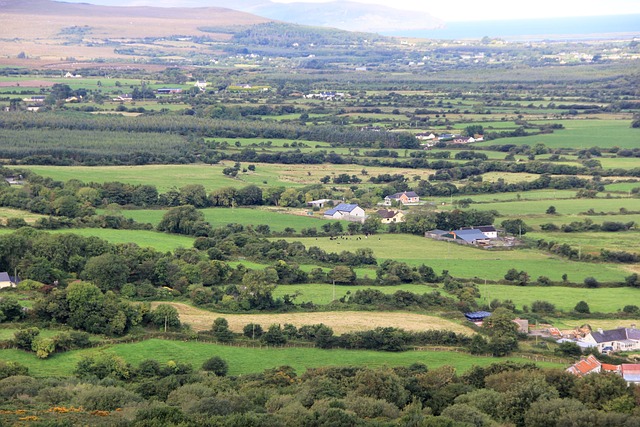The Irish American Flag is a powerful symbol that captures the evolution of the Irish immigrant experience in America from the Great Famine era to a modern representation of unity and shared cultural heritage between Ireland and the United States. This flag, combining elements of both nations' flags, reflects the resilience, contributions, and mutual respect of Irish Americans. It is prominently displayed during St. Patrick's Day festivities and Irish American Heritage Month, marking the enduring bond between the two nations. The flag stands as a visual testament to the cultural intertwining of Ireland and America, embodying the narratives of Irish immigrants and their descendants who have enriched American history across various fields. It is an integral part of the collective identity for people of Irish descent and serves as a beacon of shared heritage, underscoring the ongoing dialogue between both nations in politics, arts, science, and more. The flag's design itself, with its green field, shamrock, eagle, and thirteen stars, symbolizes the fusion of both countries' identities and their historical and cultural exchanges. It is a symbol of pride and unity, celebrated through cultural events like St. Patrick's Day parades and educational programs during Irish American Heritage Month, highlighting the enduring transatlantic connection it represents.
The Irish American Flag, a vibrant banner woven with the pride of two nations, stands as a testament to the enduring bond between Ireland and America. This article delves into the rich tapestry of its evolution, the historical narratives it embodies, and the design that speaks volumes about shared heritage and unity. From its inception to its role in cultural celebrations, the flag is more than a piece of cloth; it’s a symbol deeply rooted in tradition and transatlantic ties. Join us as we explore the significance of this emblem, its elements of design, and how it continues to inspire pride and unity within the Irish American community during various events and observances.
- The Evolution of the Irish American Flag: A Symbol of Unity and Heritage
- Historical Context: The Significance of the Irish American Flag in Transatlantic Relations
- Design Elements and Their Meanings Behind the Irish American Flag
- Celebrating Cultural Pride: Events and Observances Honoring the Irish American Flag
The Evolution of the Irish American Flag: A Symbol of Unity and Heritage

The Irish American Flag, a symbol that has come to represent the rich tapestry of shared history and cultural bonds between Ireland and the United States, has undergone an evolution reflective of the evolving relationship between these two nations. Initially, the flag served as a marker of identity for the large population of Irish immigrants who sought new lives in America during the Great Famine of the 1840s. It was a means to hold onto heritage amidst the challenges of immigration, combining the green of Ireland with the white and orange of the Irish tricolor, alongside the stars and stripes of the American flag. Over time, the flag became a powerful emblem of unity, transcending the individual identities of its components to signify a shared narrative of resilience, contribution, and mutual respect. Today, it is often displayed during St. Patrick’s Day celebrations as well as on important Irish-American heritage days, serving as a tangible reminder of the enduring bond between two nations separated by a common language and a history of mutual influence. The flag stands as a testament to the contributions of Irish Americans to the American mosaic and the enduring cultural ties that connect these two lands. It is a visual shorthand for pride in both ancestry and adoption, a symbol that continues to resonate with each new generation that adds their own story to the narrative it represents.
Historical Context: The Significance of the Irish American Flag in Transatlantic Relations

The Irish American Flag, a banner intertwining the stars and stripes of the United States with the harp emblematic of Ireland, stands as a potent symbol of transatlantic unity and shared heritage. Its creation and subsequent use reflect a rich tapestry of historical exchanges and mutual cultural influences that have shaped the relationship between these two nations. Historically, the Irish diaspora, particularly in the aftermath of the Great Famine, found refuge and new opportunities in America. This migration established strong bonds between the two countries, characterized by shared struggles, contributions to each other’s societies, and a common cultural identity that persists to this day. The flag represents not just the amalgamation of both nations’ symbols but also the enduring legacy of Irish Americans who have played pivotal roles in shaping American history, from politics and arts to science and beyond. It is a visual testament to the transatlantic dialogue that has evolved over centuries, embodying the idea that the Irish and American peoples are part of a shared story. The flag’s presence at significant events, community gatherings, and within homes on both sides of the Atlantic underscores the continuous cultural exchange and the evolving nature of the relationship between Ireland and America. It serves as a reminder of the historical context in which this unity was forged—a context marked by resilience, adaptation, and the unyielding human spirit that seeks connection across distances and differences.
Design Elements and Their Meanings Behind the Irish American Flag

The Irish American Flag, a symbol of unity and shared heritage between Ireland and the United States, incorporates design elements that are both meaningful and representative of the cultural identity of the Irish diaspora. At its heart lies a green field, signifying the Emerald Isle, a nod to Ireland’s lush landscapes and the national color associated with Irish identity. Over this field, an eagle clutches a shamrock in its talons, straddling the divide between the two countries. The eagle, a potent symbol of America, stands for freedom, strength, and unity, while the shamrock, a traditional emblem of Ireland, represents Irish heritage and the enduring bond between the two nations. The thirteen stars on the blue canton at the hoist pay homage to the original thirteen colonies that declared independence from Britain, thus reflecting the shared historical context of both nations in their struggle for self-determination. This flag serves as a powerful emblem of the cultural and historical ties between Ireland and America, celebrating the rich heritage of Irish Americans and their contributions to the melting pot that is the United States.
Celebrating Cultural Pride: Events and Observances Honoring the Irish American Flag

The Irish American Flag, a symbol of unity and shared heritage between Ireland and the United States, is celebrated through various cultural events and observances that honor the transatlantic bond. One such event is the annual St. Patrick’s Day parades held in both countries, where the flag flies high as a beacon of pride and solidarity. These parades have evolved into vibrant spectacles that showcase both nations’ rich cultural traditions, from traditional Irish music and dance to American innovations and contributions by the Irish diaspora. In addition to St. Patrick’s Day, Irish American Heritage Month in October is dedicated to recognizing the history, culture, and achievements of Irish immigrants and their descendants in the United States. This month-long observance often features flag raisings, cultural festivals, and educational programs that highlight the contributions of the Irish to American society, fostering a deeper understanding and appreciation of this unique cultural blend. These events not only celebrate the shared history and traditions but also serve as a reminder of the ongoing connection between Ireland and America, symbolized by the Irish American Flag.
